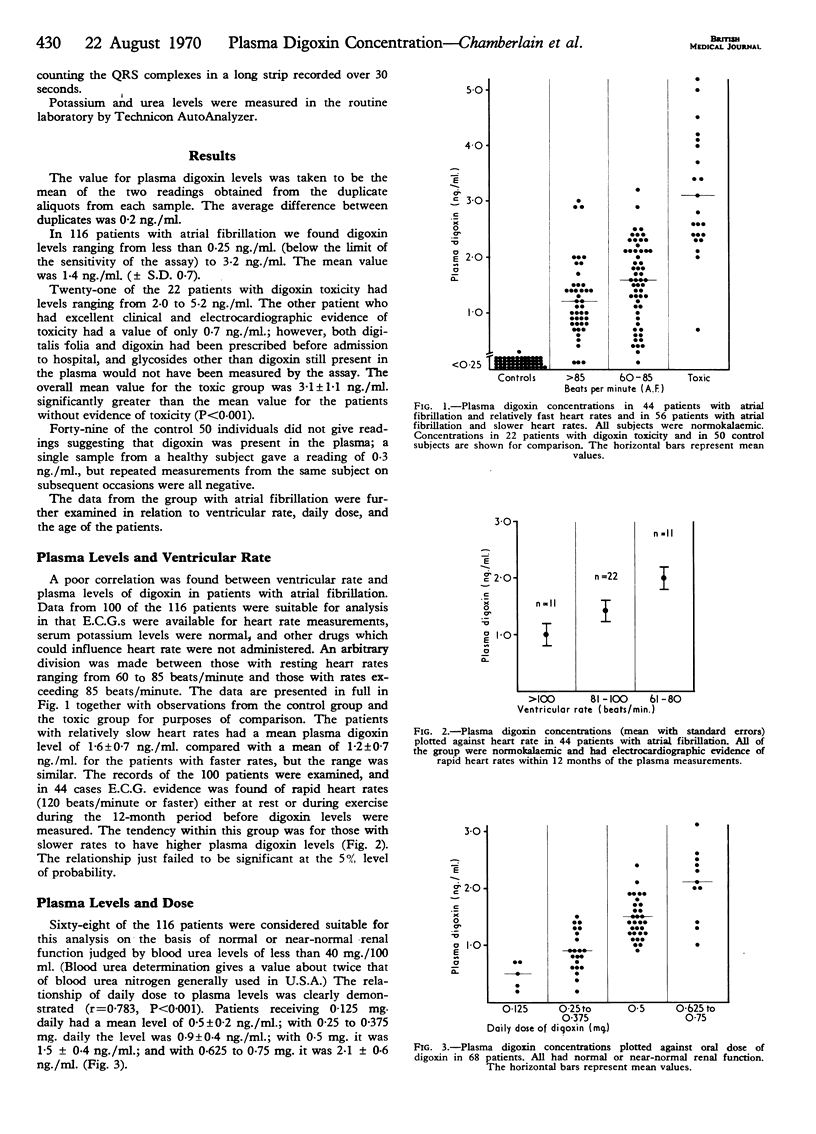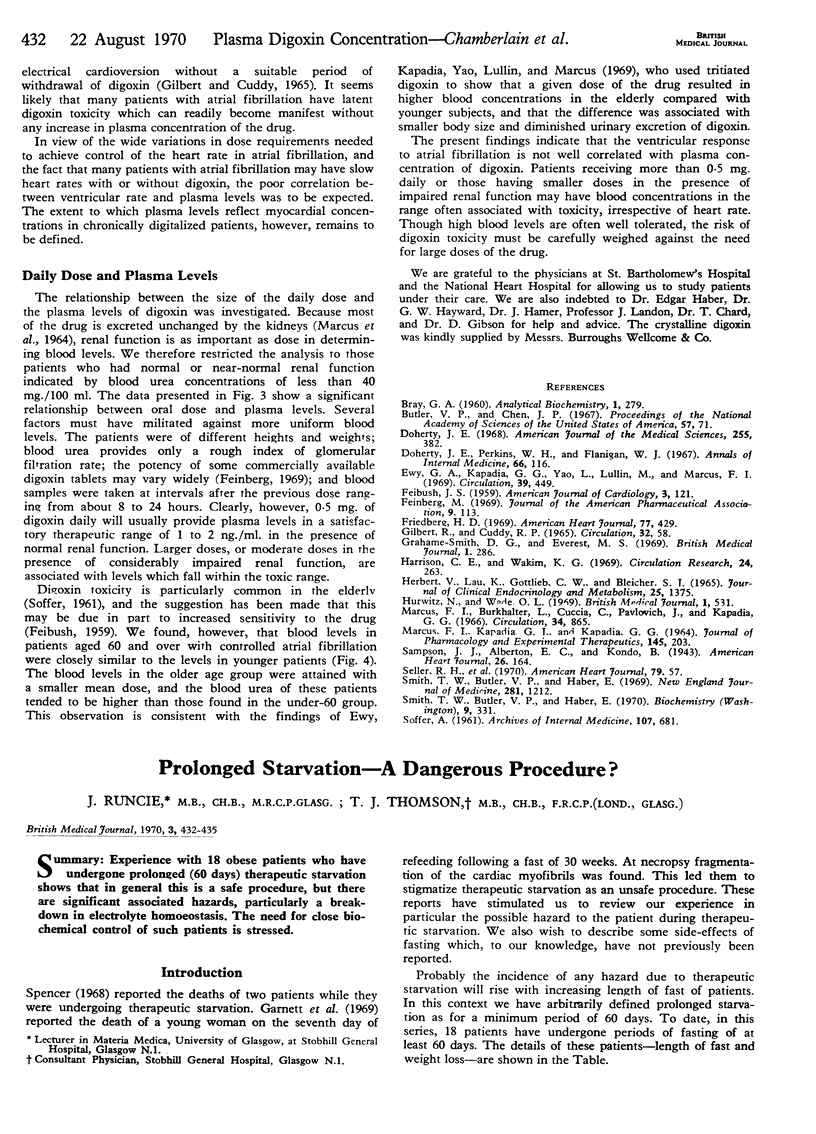Abstract
Plasma digoxin concentrations were measured by radioimmunoassay in 116 patients with atrial fibrillation on long-term oral treatment with the drug, and in 23 patients with digoxin toxicity. The mean concentrations were 1·4 ng./ml. and 3·1 ng./ml., respectively. Though an overlap occurred between the therapeutic and toxic ranges, toxicity is unlikely to occur below a level of 2 ng./ml. Plasma concentration showed a poor correlation with resting heart rate during atrial fibrillation. In patients with good renal function, however, a significant correlation was found between oral dose and plasma concentration. No evidence was obtained for increased sensitivity to therapeutic concentrations of the drug in elderly subjects, but the doses required to achieve these concentrations tended to be less than in younger patients.
Full text
PDF



Selected References
These references are in PubMed. This may not be the complete list of references from this article.
- Butler V. P., Jr, Chen J. P. Digoxin-specific antibodies. Proc Natl Acad Sci U S A. 1967 Jan;57(1):71–78. doi: 10.1073/pnas.57.1.71. [DOI] [PMC free article] [PubMed] [Google Scholar]
- Doherty J. E., Perkins W. H., Flanigan W. J. The distribution and concentration of tritiated digoxin in human tissues. Ann Intern Med. 1967 Jan;66(1):116–124. doi: 10.7326/0003-4819-66-1-116. [DOI] [PubMed] [Google Scholar]
- Ewy G. A., Kapadia G. G., Yao L., Lullin M., Marcus F. I. Digoxin metabolism in the elderly. Circulation. 1969 Apr;39(4):449–453. doi: 10.1161/01.cir.39.4.449. [DOI] [PubMed] [Google Scholar]
- Feinberg M. Drug standards in military procurement. J Am Pharm Assoc. 1969 Mar;9(3):113–passim. doi: 10.1016/s0003-0465(15)31812-7. [DOI] [PubMed] [Google Scholar]
- Friedberg H. D. Atrial fibrillation and digitalis toxicity. Am Heart J. 1969 Mar;77(3):429–430. doi: 10.1016/0002-8703(69)90201-4. [DOI] [PubMed] [Google Scholar]
- GILBERT R., CUDDY R. P. DIGITALIS INTOXICATION FOLLOWING CONVERSION TO SINUS RHYTHM. Circulation. 1965 Jul;32:58–64. doi: 10.1161/01.cir.32.1.58. [DOI] [PubMed] [Google Scholar]
- Grahame-Smith D. G. Everest MS: Measurement of digoxin in plasma and its use in diagnosis of digoxin intoxication. Br Med J. 1969 Feb 1;1(5639):286–289. doi: 10.1136/bmj.1.5639.286. [DOI] [PMC free article] [PubMed] [Google Scholar]
- Harrison C. E., Jr, Wakim K. G. Inhibition of binding of tritiated digoxin to myocardium by sodium depletion in dogs. Circ Res. 1969 Feb;24(2):263–268. doi: 10.1161/01.res.24.2.263. [DOI] [PubMed] [Google Scholar]
- Herbert V., Lau K. S., Gottlieb C. W., Bleicher S. J. Coated charcoal immunoassay of insulin. J Clin Endocrinol Metab. 1965 Oct;25(10):1375–1384. doi: 10.1210/jcem-25-10-1375. [DOI] [PubMed] [Google Scholar]
- MARCUS F. I., KAPADIA G. J., KAPADIA G. G. THE METABOLISM OF DIGOXIN IN NORMAL SUBJECTS. J Pharmacol Exp Ther. 1964 Aug;145:203–209. [PubMed] [Google Scholar]
- Marcus F. I., Burkhalter L., Cuccia C., Pavlovich J., Kapadia G. G. Administration of tritiated digoxin with and without a loading dose. A metabolic study. Circulation. 1966 Nov;34(5):865–874. doi: 10.1161/01.cir.34.5.865. [DOI] [PubMed] [Google Scholar]
- Smith T. W., Butler V. P., Jr, Haber E. Characterization of antibodies of high affinity and specificity for the digitalis glycoside digoxin. Biochemistry. 1970 Jan 20;9(2):331–337. doi: 10.1021/bi00804a020. [DOI] [PubMed] [Google Scholar]
- Smith T. W., Butler V. P., Jr, Haber E. Determination of therapeutic and toxic serum digoxin concentrations by radioimmunoassay. N Engl J Med. 1969 Nov 27;281(22):1212–1216. doi: 10.1056/NEJM196911272812203. [DOI] [PubMed] [Google Scholar]


